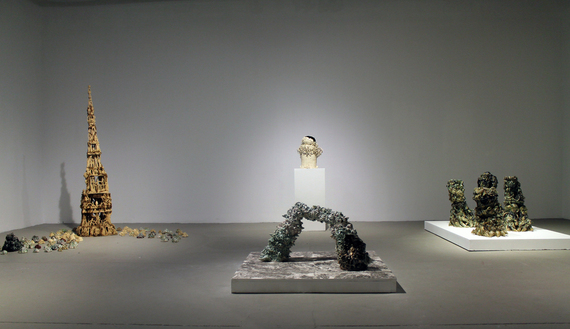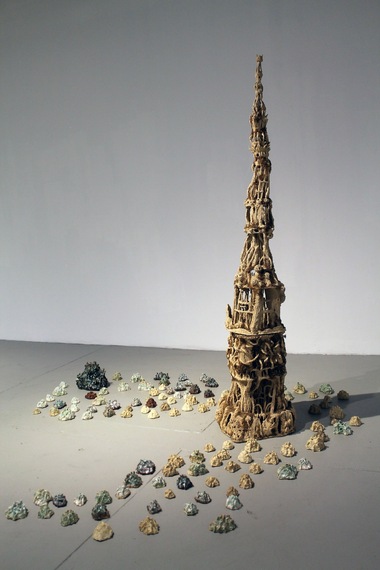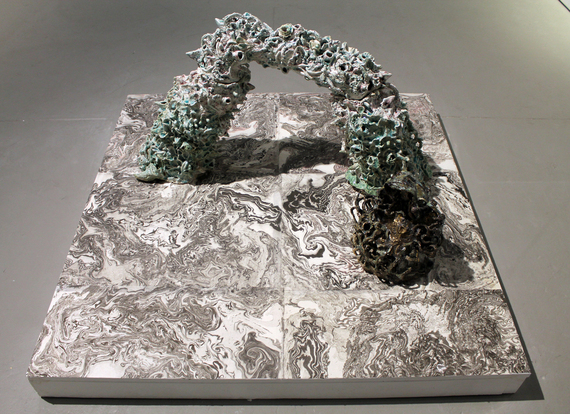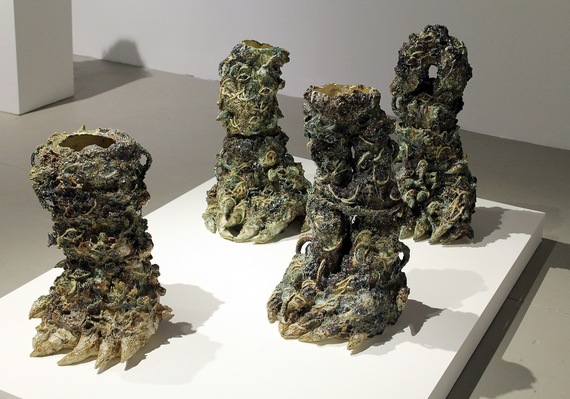"To live, to lie awake / under scarred plaster / while ice is forming over the earth...to know the composing of the thread / inside the spider's body / first atoms of the web / visible tomorrow...Nothing can be done but by inches...numbering the striations / of air inside the ice cube / imagining the existence / of something uncreated." -Adrienne Rich
Alongside disintegration, new life takes hold, such as a labyrinth of barnacles or a twisting of roots and vines. In Heidi Lau's sculptures in Vestiges from a Dream Pool at Real Art Ways, the memory of form persists and adjoins with natural elements to become patterns that progress alongside absence, and something ancient is invited to enter and take hold. We sense aquatic modes of being and growth formations that allow for survival but on a marvelously fragile basis, dependent on energy's microscopic conversions and surrendering to mythological layers and archaic systems. Often referencing Daoist creation myths and reincarnation stories, existence seems like a delicate experiment in her sculptures, and Lau enhances this with the supernatural enchantment of the half-destroyed. Slow animated notions of residue settle and merge with patterns that suggest time has passed in due course -- time has passed in no hurry. Lau's sculptures embody tales of disintegration, and what is left is not meant to survive the form of one physical presence, but may become many new things, chimerical and sensual in the act of transforming. In her sculptures, hues of green echo stories and scripts we faintly detect. Lau evokes a consciousness of the environment, including loss and recovery. This sense of rebirth and the surge of survival can be felt as hopeful aspects of her work. The creatures that would inhabit these constructions are not of the human sphere, and they may be of the present, the future or the past. They evoke otherworldliness and imperil one's sense of knowing.
Lau presents patterning as if from nature: tangles of stems and thorns, plant debris and thickets, roots, coral reefs, mud deposits and organic sedimentary. Max Ernst was known to summon the complex textures in his landscapes by doing rubbings of various objects, both natural and man-made. Eugene Von Bruenchenhein painted his strange towers and cloud forms with clasps of his wife's hair. Both of these artists are recalled in Lau's sculptures, all of them edge us into other worlds. A sense of transfer occurs where substance subsumes all content, and yet is alive with content. Washed over by change, memory morphs into mythopoetic realms; the skeleton fortress has no specific inhabitants and the megalith dream structure goes on and on. Do we gaze upon the fortress, look back at what is lost, or look inward with realization? What's left is the pile, the arch and claw, the shell, the split from time and the endurance of time at once. The action of drifting in water or wind, via trial and error, belongs in the past. The effort of survival is distant but not a silhouette.
The sculpture "The Gate and its Keeper" has a personal back-story: when Lau's grandmother was young, in Macau, she became gravely ill. As a means to prevent death, a local priest conducted a ceremony to make her the goddaughter of the gate keeper to the after-life. Attributing her survival to this ceremony, Lau has memories of her grandmother providing offerings to a local statue of her godfather, the gate keeper. The statue that Lau created is an arch bridging two worlds, reflecting the story of coming back from the dead, or revisiting memory.
Lau describes working with clay as an intuitive process, starting with only a vague idea of a concept: "The clay tells me what to do." She notes that she is "using supernatural stories of reincarnation and old Chinese myths to figure out who I am." Much of Lau's childhood in Macau was during a time prior to the handover to the People's Republic of China, in 1999. In the present day, Macau is wealthy as a result of the gambling industry and tourism, but Lau grew up around ruins during most of her childhood. Prior to the handover, Lau describes how Macau, as a colony, was "hidden, in disarray, and falling apart," and she was "drawn to things that were left behind." She describes a tragic feeling as well as the intrigue of exploring abandoned houses that gave shelter to wild animals, dense with plant growth taking over.
In "Vestiges from a Dream Pool", Lau presents imagined states of being, and the objects flourish with absence and change, where our impact on nature becomes nature's impact on us. Lau's work is influenced by the friction of natural forces along with inseparability and the interconnectedness of before and after. In her work, the ecological realm becomes intimately linked with the mythical and then further intensified. In "Pillars of the Earth (Modeled after Lonesome George)," a procession of skeleton tortoise claws traverse a timeless plane where the animal walks again as a kind of hope-memory. Can the extinct be reincarnated? Lau's sculptures are as thick as bedrock and chock full of remnants. Aside from being symbols, stories and ecological totems, they are self-portraits reflecting desire, reaching for a recovery of old ways, and reminding us, in Lau's words, of "how things could be and could have been."



